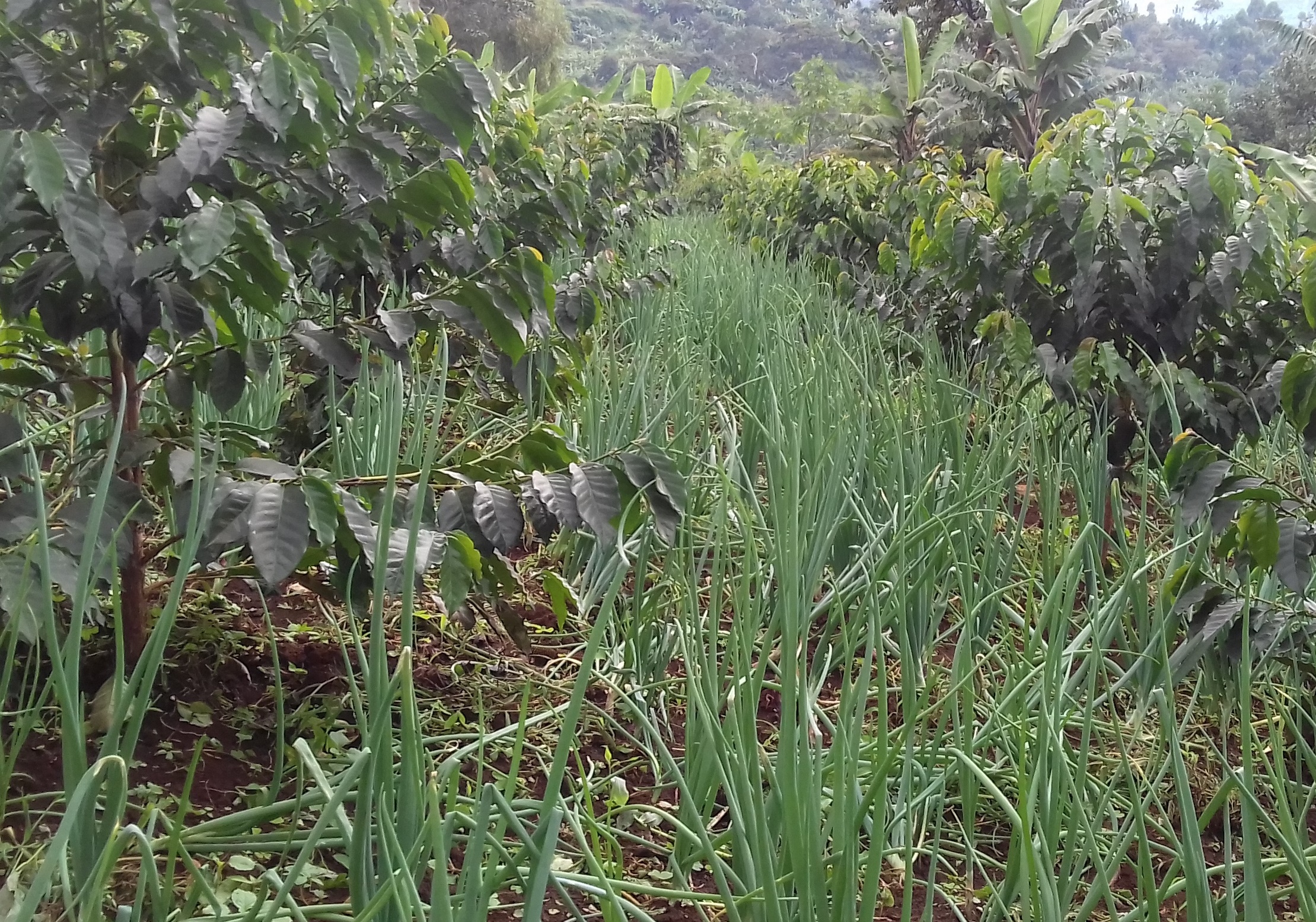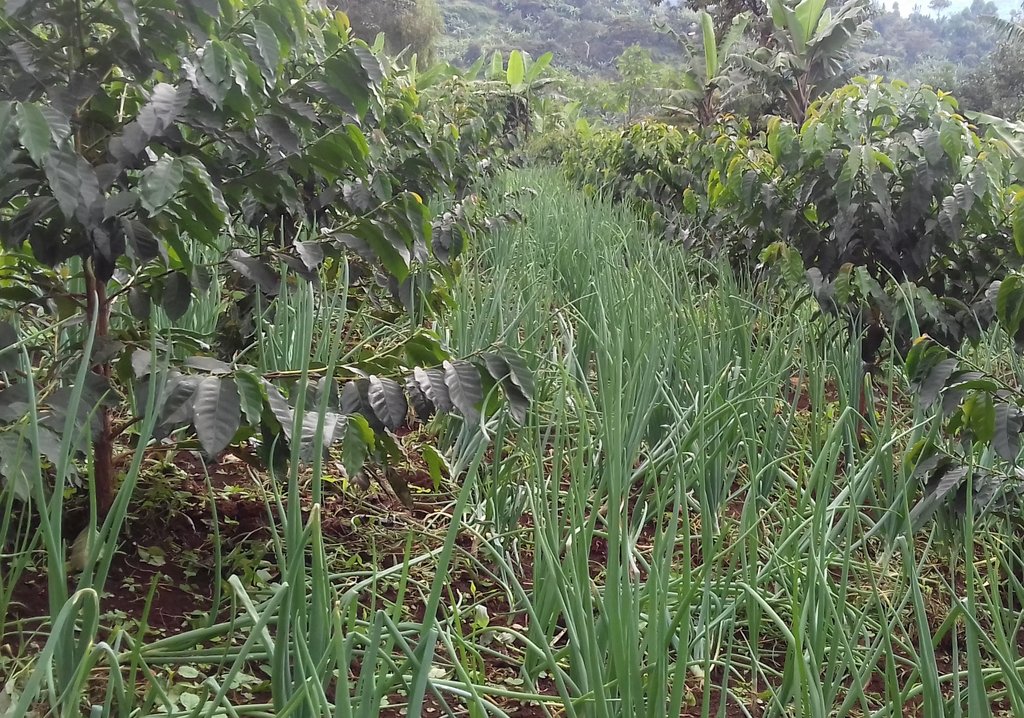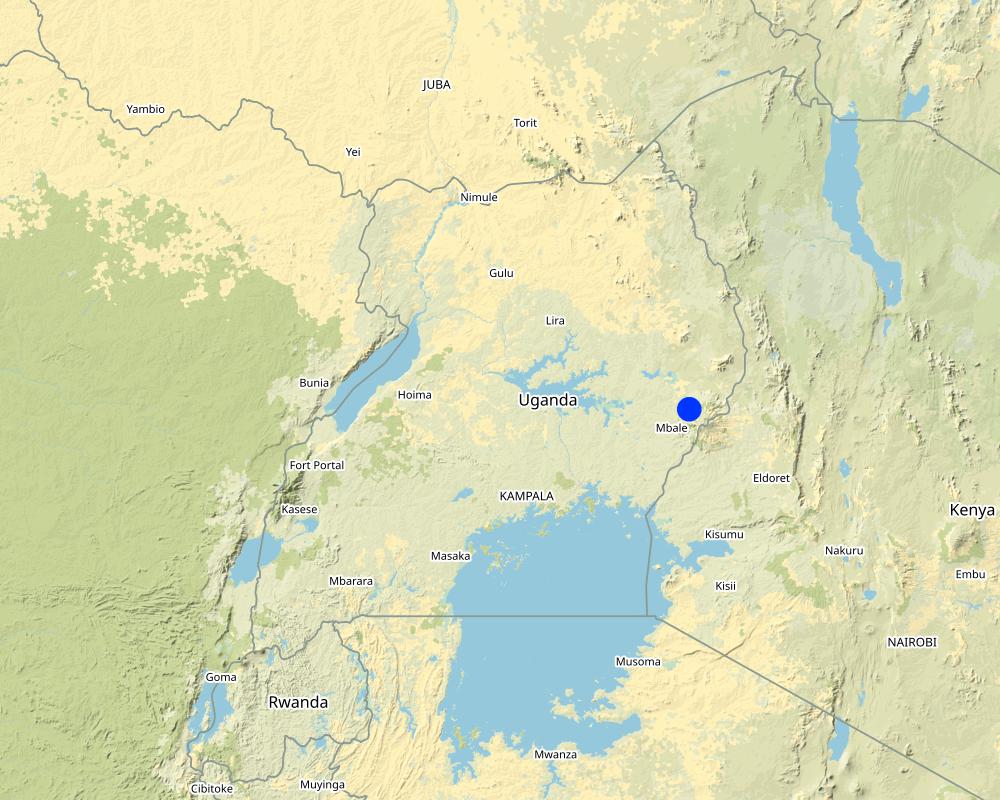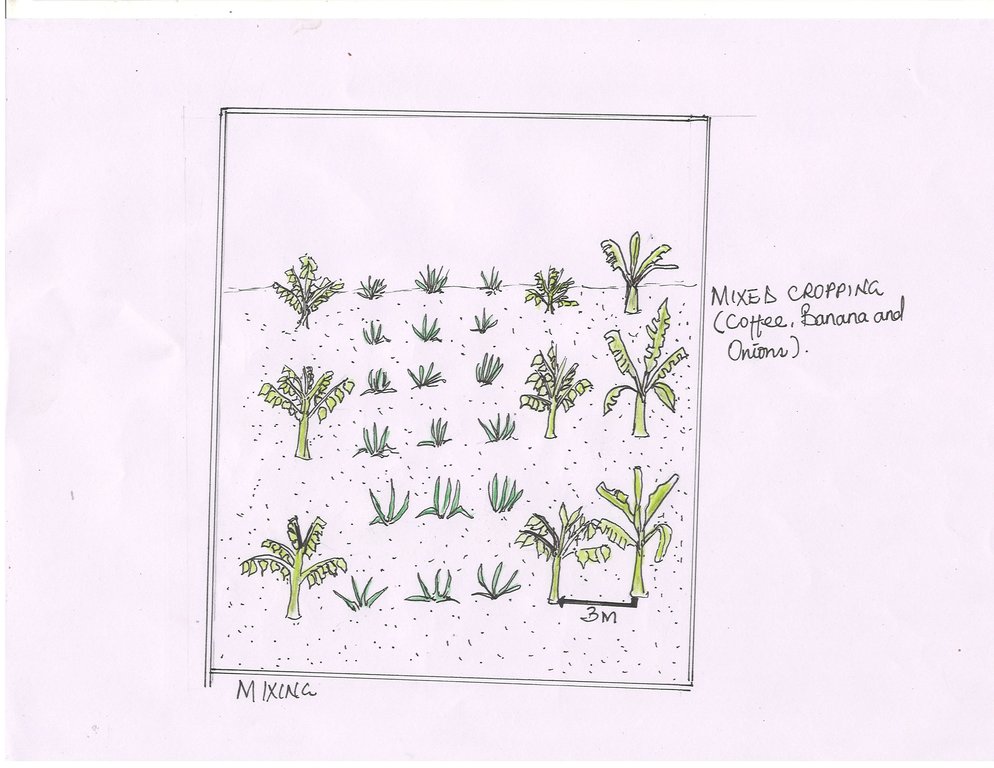Mixed Cropping of Coffee, Banana and Onions for Increased Production, Food Security and Household Income [Uganda]
- Creation:
- Update:
- Compiler: Babirye Irene
- Editor: Kamugisha Rick Nelson
- Reviewers: Nicole Harari, Udo Höggel
Okulima emwanyi, matooke n'obutugulu
technologies_3378 - Uganda
View sections
Expand all Collapse all1. General information
1.2 Contact details of resource persons and institutions involved in the assessment and documentation of the Technology
Key resource person(s)
land user:
Wogudunya Wilson
+256702390798
Duwabana Farmer's Association
Kikameli Village, Kibando town, Bulambuli District
Uganda
Name of project which facilitated the documentation/ evaluation of the Technology (if relevant)
Scaling-up SLM practices by smallholder farmers (IFAD)Name of the institution(s) which facilitated the documentation/ evaluation of the Technology (if relevant)
National Agricultural Research Organisation (NARO) - Uganda1.3 Conditions regarding the use of data documented through WOCAT
When were the data compiled (in the field)?
19/10/2017
The compiler and key resource person(s) accept the conditions regarding the use of data documented through WOCAT:
Ja
1.4 Declaration on sustainability of the described Technology
Is the Technology described here problematic with regard to land degradation, so that it cannot be declared a sustainable land management technology?
Nee
2. Description of the SLM Technology
2.1 Short description of the Technology
Definition of the Technology:
Mixed Cropping of coffee (Coffea Canephora) , banana (Musa) and onions (Allium cepa) is a sustainable traditional land management practice that involves the growing of two or more crops (coffee, banana and onions) at the same time on the same field by smallholder farmers for increased production, food security and household income.
2.2 Detailed description of the Technology
Description:
Coffee, banana and onions mixed cropping; is a traditional practice promoted by smallholder farmers in Uganda established in Bulambuli district, Kibande Sub-county, Kimameli village. The area experiences two growing seasons per year; April up to July and September up to December with rainfall ranging from 1, 0001 mm-1,500 mm on 3.4 ha of land located on a gentle sloping area. The aim of this technology is increasing food production, household income , soil fertility improvement , maximizing crop production in a context of population pressure and declining arable land size.
Banana (Musa) and coffee (Coffea Canephora) plantations were established in 2016 followed by onions (Allium cepa) later in August 2017 with Coffee (Coffea robusta) planted at a spacing of 10 feet apart from Coffee to avoid competition for soil nutrients. Using hoes, pangas, coffee and onion seedlings, banana suckers were inter cropped at the ratio of 1 banana to 4 coffee trees on a 3.4 ha. Coffee trees were pruned initially to create room for the banana plants during their establishment. When coffee and banana were planted simultaneously in the field, onions were grown in between them for one year to provide some income before the banana and coffee were ready for harvesting. To establish such a technology the farmer accomplished the following activities: 1.preparing the garden (labor time: four days with three people), 2.Manure application where compost manure was mixed with soil (labor time: one day by three people), 3. Planting (three days by three people for all the crops), 4.Pruning where relevant adjustments were done regularly to the system (e.g. mature coffee trees are pruned to create space for onions to grow is done every three days by one person), and 5. Weeding since inter cropping requires weeding which should be done manually and not with a hoe because it may accidentally damage the roots of the coffee plant.
What is liked about this technology is that its very good according to the farmer’s experience. It is applied on a small piece of land and it incorporates many crops which helps to improve soil fertility, increase crop yield which generates more income and food for consumption. There is also good utilization of labor as a farmer will work on all the crops simultaneously. The farmer testified that bananas provide shade, mulch, nutrients and moisture to young coffee trees. These beneficial effects may particularly be relevant to increase the resilience of the coffee production systems when temperature increases and rainfall becomes more erratic due to climate change. On the other hand coffee being a perennial crop, it requires high levels of initial investment (i.e. labor and capital) with a 10 - 15 years time horizon. The extended time period before realization of economic benefits usually discourages land users from adopting coffee inter cropping with other crops. Also, coffee creates shade which does not favor the growth of maize, beans and tomatoes in the same land, hence there’s competition between the crops for nutrients.
2.3 Photos of the Technology
2.4 Videos of the Technology
Comments, short description:
The video showing coffee and banana inter-cropped with onions
Date:
18/10/2017
Location:
Kikameli village, Bulambuli District.
Name of videographer:
Irene Babirye
2.5 Country/ region/ locations where the Technology has been applied and which are covered by this assessment
Country:
Uganda
Region/ State/ Province:
Eastern Region
Further specification of location:
Kikameli village, Kibande sub-county, Bulambuli District
Map
×2.6 Date of implementation
Indicate year of implementation:
2017
2.7 Introduction of the Technology
Specify how the Technology was introduced:
- through land users' innovation
- through projects/ external interventions
Comments (type of project, etc.):
Land user knew about the technology but he was motivated through projects
3. Classification of the SLM Technology
3.1 Main purpose(s) of the Technology
- improve production
- reduce, prevent, restore land degradation
- conserve ecosystem
- adapt to climate change/ extremes and its impacts
- create beneficial economic impact
3.2 Current land use type(s) where the Technology is applied

Cropland
- Annual cropping
- Perennial (non-woody) cropping
Main crops (cash and food crops):
Coffee, Banana and Onions
3.3 Further information about land use
Water supply for the land on which the Technology is applied:
- rainfed
Number of growing seasons per year:
- 2
Specify:
March to May and September to December
3.4 SLM group to which the Technology belongs
- integrated soil fertility management
- integrated pest and disease management (incl. organic agriculture)
- home gardens
3.5 Spread of the Technology
Specify the spread of the Technology:
- evenly spread over an area
If the Technology is evenly spread over an area, indicate approximate area covered:
- < 0.1 km2 (10 ha)
Comments:
The technology is practiced on 3.5 hectares.
3.6 SLM measures comprising the Technology

agronomic measures
- A1: Vegetation/ soil cover
- A2: Organic matter/ soil fertility

management measures
- M4: Major change in timing of activities
- M6: Waste management (recycling, re-use or reduce)
3.7 Main types of land degradation addressed by the Technology

soil erosion by water
- Wt: loss of topsoil/ surface erosion

soil erosion by wind
- Et: loss of topsoil

biological degradation
- Bq: quantity/ biomass decline
- Bp: increase of pests/ diseases, loss of predators
3.8 Prevention, reduction, or restoration of land degradation
Specify the goal of the Technology with regard to land degradation:
- prevent land degradation
- reduce land degradation
Comments:
The technology prevents and reduces land degradation through reduced soil erosion and soil exposure and increase soil cover.
4. Technical specifications, implementation activities, inputs, and costs
4.1 Technical drawing of the Technology
4.2 Technical specifications/ explanations of technical drawing
Banana and coffee plantations were established in 2016 and onions added later in August 2017. This practice is carried out on 3.4 ha.
Coffee is the major crop planted with spacing of 3m x 3m, then banana was intercropped at the ratio of 1 banana to 4 coffee trees.
The coffee trees were pruned initially to create room for the banana plants during their establishment. When coffee and banana were planted simultaneously in the field, onions were grown in between them for one year to provide some income before the banana and coffee were ready for harvesting.
The activities and labor demands include:
Digging holes and preparing the garden (labour time: 4 days by 3 people).
Manure application where compost manure was mixed with soil (labour time: 1 day by 3 people).
Planting (3 days by 3 people for all the crops).
Pruning where relevant adjustments are done regularly to the system (e.g. mature coffee trees are pruned to create space for onions to grow is done every three days by one person).
Labor costs are 5000 Uganda shillings per person a day.
Coffee takes three years for the first harvest to happen, onions take four months to grow - here harvesting is continuous.
4.3 General information regarding the calculation of inputs and costs
Specify how costs and inputs were calculated:
- per Technology area
Indicate size and area unit:
3.4 hectares
Specify currency used for cost calculations:
- US Dollars
Indicate exchange rate from USD to local currency (if relevant): 1 USD =:
3600.0
Indicate average wage cost of hired labour per day:
1.39
4.4 Establishment activities
| Activity | Type of measure | Timing | |
|---|---|---|---|
| 1. | Digging/ Garden preparation | Agronomic | 1 week before the rains |
| 2. | Fertilizer Application | Agronomic | 2 days |
| 3. | Planting | Agronomic | Before onset of rains |
| 4. | Spraying | Agronomic | Every after two weeks |
| 5. | Prunning | Agronomic | monthly |
| 6. | Harvesting | Agronomic | Seasonal |
Comments:
Harvesting onions is done every after three months.
4.5 Costs and inputs needed for establishment
| Specify input | Unit | Quantity | Costs per Unit | Total costs per input | % of costs borne by land users | |
|---|---|---|---|---|---|---|
| Labour | Digging/Garden preparations | man days | 4.0 | 1.39 | 5.56 | 100.0 |
| Labour | Planting | man days | 4.0 | 1.39 | 5.56 | 100.0 |
| Labour | Spraying | man days | 1.0 | 1.39 | 1.39 | 100.0 |
| Labour | Pruning | man days | 1.0 | 1.39 | 1.39 | 100.0 |
| Equipment | Hoes | Piece | 4.0 | 2.78 | 11.12 | 100.0 |
| Equipment | Pangas | Piece | 2.0 | 2.78 | 5.56 | 100.0 |
| Equipment | Wheelbarrow | Piece | 1.0 | 33.4 | 33.4 | 100.0 |
| Equipment | Sprayer pump | Piece | 1.0 | 13.9 | 13.9 | 100.0 |
| Plant material | Onions Seeds | kilograms | 2.0 | 1.94 | 3.88 | 100.0 |
| Plant material | Coffee seedlings | pieces | 2000.0 | 0.83 | 1660.0 | 100.0 |
| Plant material | Banana suckers | pieces | 2000.0 | 0.83 | 1660.0 | 100.0 |
| Fertilizers and biocides | Animal Manure | Trip | 1.0 | 22.3 | 22.3 | 100.0 |
| Fertilizers and biocides | NPK Mineral fertiliser | Kilograms | 5.0 | 0.84 | 4.2 | 100.0 |
| Fertilizers and biocides | Herbicides | litres | 2.0 | 3.34 | 6.68 | 100.0 |
| Fertilizers and biocides | Pesticides | litres | 2.0 | 4.17 | 8.34 | 100.0 |
| Total costs for establishment of the Technology | 3443.28 | |||||
If land user bore less than 100% of costs, indicate who covered the remaining costs:
The land user incurred all the costs
Comments:
The farmer got a loan from the village saving loan group to establish the technology
4.6 Maintenance/ recurrent activities
| Activity | Type of measure | Timing/ frequency | |
|---|---|---|---|
| 1. | Weeding | Management | weekly |
| 2. | Spraying | Management | weekly |
| 3. | Pruning | Management | monthly |
4.7 Costs and inputs needed for maintenance/ recurrent activities (per year)
| Specify input | Unit | Quantity | Costs per Unit | Total costs per input | % of costs borne by land users | |
|---|---|---|---|---|---|---|
| Labour | Weeding | Man Days | 2.0 | 2.8 | 5.6 | 100.0 |
| Labour | Spraying | Man Days | 1.0 | 2.8 | 2.8 | 100.0 |
| Equipment | Spray Pump | piece | 1.0 | 1.39 | 1.39 | 100.0 |
| Equipment | Hoes | pieces | 2.0 | 2.78 | 5.56 | 100.0 |
| Fertilizers and biocides | NPK Fertiliser | Kilograms | 8.0 | 1.39 | 11.12 | 100.0 |
| Fertilizers and biocides | Dudu cyper (pesticide) | litres | 2.0 | 1.39 | 2.78 | 100.0 |
| Fertilizers and biocides | Dythene (herbicide) | kilograms | 2.0 | 6.95 | 13.9 | 100.0 |
| Total costs for maintenance of the Technology | 43.15 | |||||
Comments:
The land user incurs all the costs.
4.8 Most important factors affecting the costs
Describe the most determinate factors affecting the costs:
Fertilizers are very expensive to be applied monthly
5. Natural and human environment
5.1 Climate
Annual rainfall
- < 250 mm
- 251-500 mm
- 501-750 mm
- 751-1,000 mm
- 1,001-1,500 mm
- 1,501-2,000 mm
- 2,001-3,000 mm
- 3,001-4,000 mm
- > 4,000 mm
Specify average annual rainfall (if known), in mm:
1600.00
Specifications/ comments on rainfall:
The zone receives a bi-model pattern of rainfall
Indicate the name of the reference meteorological station considered:
Buginyanya zonal Agricultural Research and Development Institute
Agro-climatic zone
- humid
5.2 Topography
Slopes on average:
- flat (0-2%)
- gentle (3-5%)
- moderate (6-10%)
- rolling (11-15%)
- hilly (16-30%)
- steep (31-60%)
- very steep (>60%)
Landforms:
- plateau/plains
- ridges
- mountain slopes
- hill slopes
- footslopes
- valley floors
Altitudinal zone:
- 0-100 m a.s.l.
- 101-500 m a.s.l.
- 501-1,000 m a.s.l.
- 1,001-1,500 m a.s.l.
- 1,501-2,000 m a.s.l.
- 2,001-2,500 m a.s.l.
- 2,501-3,000 m a.s.l.
- 3,001-4,000 m a.s.l.
- > 4,000 m a.s.l.
Indicate if the Technology is specifically applied in:
- not relevant
5.3 Soils
Soil depth on average:
- very shallow (0-20 cm)
- shallow (21-50 cm)
- moderately deep (51-80 cm)
- deep (81-120 cm)
- very deep (> 120 cm)
Soil texture (topsoil):
- medium (loamy, silty)
Soil texture (> 20 cm below surface):
- medium (loamy, silty)
Topsoil organic matter:
- medium (1-3%)
5.4 Water availability and quality
Ground water table:
on surface
Availability of surface water:
medium
Water quality (untreated):
good drinking water
Is water salinity a problem?
Nee
Is flooding of the area occurring?
Nee
5.5 Biodiversity
Species diversity:
- low
Habitat diversity:
- low
5.6 Characteristics of land users applying the Technology
Sedentary or nomadic:
- Sedentary
Market orientation of production system:
- mixed (subsistence/ commercial
Off-farm income:
- 10-50% of all income
Relative level of wealth:
- average
Individuals or groups:
- individual/ household
Level of mechanization:
- manual work
Gender:
- men
Age of land users:
- elderly
Indicate other relevant characteristics of the land users:
The farmer's main source of income is agriculture.
5.7 Average area of land owned or leased by land users applying the Technology
- < 0.5 ha
- 0.5-1 ha
- 1-2 ha
- 2-5 ha
- 5-15 ha
- 15-50 ha
- 50-100 ha
- 100-500 ha
- 500-1,000 ha
- 1,000-10,000 ha
- > 10,000 ha
Is this considered small-, medium- or large-scale (referring to local context)?
- medium-scale
Comments:
The farmer owns 2 hectares which is considered medium compared to other land owners who own more than 5 hectares.
5.8 Land ownership, land use rights, and water use rights
Land ownership:
- individual, titled
Land use rights:
- individual
Water use rights:
- open access (unorganized)
5.9 Access to services and infrastructure
health:
- poor
- moderate
- good
education:
- poor
- moderate
- good
technical assistance:
- poor
- moderate
- good
employment (e.g. off-farm):
- poor
- moderate
- good
markets:
- poor
- moderate
- good
energy:
- poor
- moderate
- good
roads and transport:
- poor
- moderate
- good
drinking water and sanitation:
- poor
- moderate
- good
financial services:
- poor
- moderate
- good
6. Impacts and concluding statements
6.1 On-site impacts the Technology has shown
Socio-economic impacts
Production
crop production
crop quality
Quantity before SLM:
1
Quantity after SLM:
3
wood production
Comments/ specify:
The pruned trees or brunches are used as wood for firewood at home.
risk of production failure
Comments/ specify:
There is no total crop failure as the farmer gains at least from one crop.
land management
Comments/ specify:
The land user grows many crops on the same land hence the available space is utilized.
Water availability and quality
drinking water availability
Quantity before SLM:
2
Quantity after SLM:
2
Comments/ specify:
There is a nearby water source
Income and costs
expenses on agricultural inputs
Quantity before SLM:
3
Quantity after SLM:
2
diversity of income sources
Quantity before SLM:
1
Quantity after SLM:
3
Socio-cultural impacts
food security/ self-sufficiency
Comments/ specify:
There is increased food production as the farmer grows more than one crop
SLM/ land degradation knowledge
Comments/ specify:
The land user improved land management skills.
Ecological impacts
Water cycle/ runoff
evaporation
Comments/ specify:
Through inter-cropping less soil is exposed to the sun hence reduced soil moisture loss.
6.2 Off-site impacts the Technology has shown
damage on neighbours' fields
Comments/ specify:
The land user has trenches which prevent water and soil damage on the neighbor's fields
6.3 Exposure and sensitivity of the Technology to gradual climate change and climate-related extremes/ disasters (as perceived by land users)
Gradual climate change
Gradual climate change
| Season | Type of climatic change/ extreme | How does the Technology cope with it? | |
|---|---|---|---|
| annual rainfall | decrease | moderately | |
| seasonal rainfall | wet/ rainy season | decrease | moderately |
Climate-related extremes (disasters)
Meteorological disasters
| How does the Technology cope with it? | |
|---|---|
| local rainstorm | moderately |
6.4 Cost-benefit analysis
How do the benefits compare with the establishment costs (from land users’ perspective)?
Short-term returns:
positive
Long-term returns:
very positive
How do the benefits compare with the maintenance/ recurrent costs (from land users' perspective)?
Short-term returns:
positive
Long-term returns:
very positive
6.5 Adoption of the Technology
- 1-10%
If available, quantify (no. of households and/ or area covered):
Three farmers in the area.
Of all those who have adopted the Technology, how many have did so spontaneously, i.e. without receiving any material incentives/ payments?
- 90-100%
Comments:
All the farmers who adopted the technology used their personal investments.
6.6 Adaptation
Has the Technology been modified recently to adapt to changing conditions?
Ja
If yes, indicate to which changing conditions it was adapted:
- changing markets
6.7 Strengths/ advantages/ opportunities of the Technology
| Strengths/ advantages/ opportunities in the land user’s view |
|---|
| The technology suppresses weed growth |
| The technology reduces soil erosion. |
| Yield and income advantage as the farmer gains from more than one crop from the same plot. Income recived is invested in buying tree seedlings |
| Reduced crop failure as there is no total crop failure |
| Strengths/ advantages/ opportunities in the compiler’s or other key resource person’s view |
|---|
| The technology helps the farmer to grow many crops on a small piece of land. |
| Technology can be promoted by other farmers with same pieces of land or more. |
| It increases crop yield which generates more income and food for consumption. |
6.8 Weaknesses/ disadvantages/ risks of the Technology and ways of overcoming them
| Weaknesses/ disadvantages/ risks in the land user’s view | How can they be overcome? |
|---|---|
| The technology has too much shade, so other crops cannot grow for example maize and beans. | The farmer should continue to grow onions instead of maize and beans |
| The technology is expensive to establish because high investments need to be made. | The land user should find financial assistance like savings co-operatives. |
| The technology is a long term investment since it involves coffee and banana. | The farmer should buy or rent some other land to be in position to grow other crops. |
| Weaknesses/ disadvantages/ risks in the compiler’s or other key resource person’s view | How can they be overcome? |
|---|---|
| Competition between the crops for nutrients and sunlight. | Proper selection of crops to inter-crop for example inter-crop deep rooted with shallow rooted crops. |
| The soil is highly depleted of its nutrients as more than one crop is planted. | Inter cropping with some nutrient fixing crops and addition of manure. |
| There is also more work required at the start of the cultivation and harvesting. | Proper selection of crops to inter-crop and the right spacing. |
7. References and links
7.1 Methods/ sources of information
- field visits, field surveys
2
- interviews with land users
1
7.3 Links to relevant information which is available online
Title/ description:
Annual Weather in Bulambuli District
URL:
https://weatherspark.com/y/98128/Average-Weather-in-Bulambuli-Uganda-Year-Round
Links and modules
Expand all Collapse allLinks
No links
Modules
No modules





